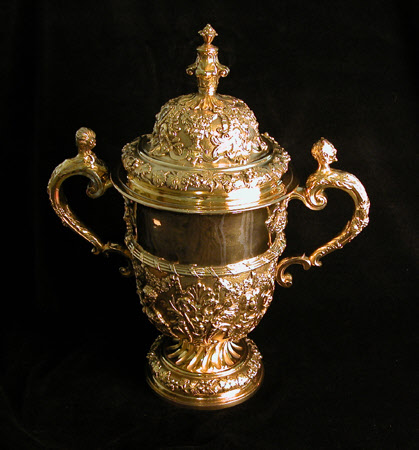Cup and cover
William Grundy (fl.1743 - 1779)
Category
Silver
Date
1746 - 1747
Materials
Silver
Measurements
38.2 x 32.4 cm; 28.4 cm (Height); 24 cm (Height); 17.1 cm (Width); 13.6 cm (Width)
Place of origin
London
Order this imageCollection
Anglesey Abbey, Cambridgeshire
NT 516445
Summary
A two-handled cup and cover, silver-gilt (sterling), mark of William Grundy, London, 1746/7. The body of the inverted bell-shaped cup and its domed cover are raised, with cast handles, finial, borders, and decoration. At the base a low circular foot ring supports a moulded border of grapes and vine leaves and the short, waisted, and spirally fluted stem. The lower body of the cup is matted. Each side is applied with an auricular mask between busts of classical figures on diaper-work pedestals. Suspended above, from an applied moulded reed and ribbon girdle, are festoons of flowers and ribbons. The upper body is undecorated except at the join of the handles, where cast and chased scrolls, vine leaves, grapes and lion masks are applied. The double scroll handles have thumbpieces formed as busts of satyrs, with fur, grapes and foliage draped over the handles. The cover has a plain rim; soldered underneath is a deep flange. A moulded border applied with vine leaves and grapes encircles the steeply rising dome, which is matted and applied with urns of flowers alternating with auricular cartouches, shells and foliage. The finial sits on a frilled base, and is formed as a group of four scrolled leaves supporting a small pinecone. Heraldry: None Hallmarks: Fully marked on the base of the cup within the foot ring: leopard’s head (London), ‘l’ (1746/7), lion passant (sterling) and ‘WG’ (William Grundy*); part marked on the flange of the cover: ‘l’, leopard’s head, lion passant, and an indistinct maker’s mark. *Arthur Grimwade: London Goldsmiths 1697-1837, London, 1990, p 222, no 3146 Scratch weight: None
Full description
Both sides of the cup would have been engraved with armorials, initials or an inscription, which have been erased. The gilding is later. Grundy made a large number of cups to this design. One of a similar shape with the same cast foot and handles but with different decoration, was sold by Bonhams in 2022. [1] Another, far more splendid example, has an openwork foot composed of the figures of four slaves seated on a flower-chased ring. The cup’s body is decorated with typical festoons of fruit and flowers, but also two rococo cartouches surrounded by imposing trophies of arms. This was sold by Sotheby’s, who reference the ‘existence of a cup of 1750 with identical finial, handles. and trophy of arms, but bearing the marks of Thomas Gilpin’. [2] This, and the fact that identical finials are found on cups with the marks of William Grundy, Thomas Gilpin and Paul de Lamerie suggests that they (like many other goldsmiths) were buying in parts, sharing models, or buying completed silverware from a so far unidentified craftsman. [1] Bonhams: Decorative Arts Through the Ages, London, 13 July 2022, Lot 14 [2] Sotheby’s: Important Silver, Silver-Gilt and Russian Works of Art from the Estate of Charles and Yvette Bluhdorn, New York, 13 October 2007, Lot 31 Jane Ewart, 2025
Provenance
(Urban) Huttleston Rogers Broughton, 1st Baron Fairhaven (1896-1966) bequeathed by Lord Fairhaven to the National Trust along with the house and the rest of the contents National Trust
Credit line
Anglesey Abbey, the Fairhaven Collection (National Trust)
Makers and roles
William Grundy (fl.1743 - 1779), goldsmith
